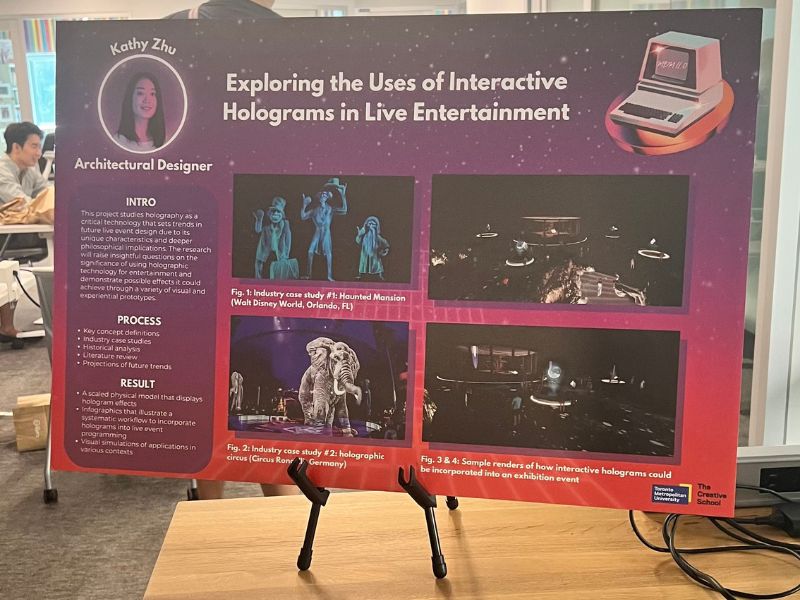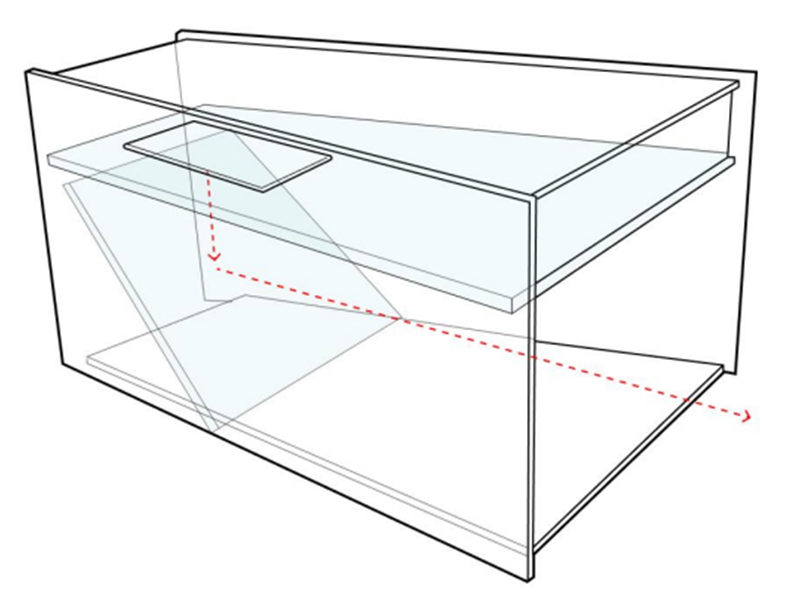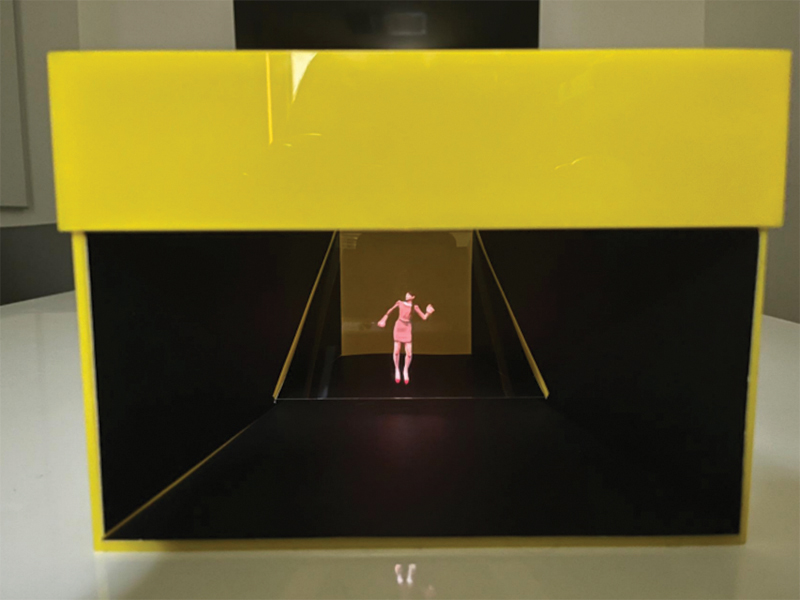Master of Digital Media student explores interactive holograms in live entertainment
In the ever-evolving landscape of live entertainment, where the intersection of technology and artistic expression ignites new dimensions of engagement, one Master of Digital Media (MDM) student's Major Research Project (MRP) stands at the forefront of innovation.
Kathy Zhu's captivating research explores the transformative potential of interactive hologram illusions within live entertainment, offering a captivating glimpse into a future where audiences become part of the show, seamlessly merging reality and imagination. Her final MRP resulted in a scaled physical model that displays hologram effects and visual simulations of her developed technology in various contexts, such as concerts and exhibitions.

Kathy Zhu’s MRP display at the year-end MDM showcase
The entertainment industry has perpetually pushed the boundaries of creativity and technology, with holographic technology steadily growing in popularity over the last decade. Its allure has captivated audiences through live projections of late artists such as Tupac Shakur and Michael Jackson, to its ability to fully immerse audiences in virtual realities with the integration of augmented reality (AR). After a global pandemic that shuttered live events across the globe, the growing need for some professionals, including Kathy Zhu, to explore this transformative power of holographic technology in live entertainment became even more pressing.
Exploring the holographic frontier
With a background in architecture and a specialization in technology, Zhu’s penchant for design has always been centred around the potential augmentation of physical spaces through digital technology. Exploring this intersection led her on the path of the MDM program and played an integral role in pursuing her thesis project.
“It’s my belief that digital media is capable of revolutionizing every industry in the forthcoming decade, with the entertainment sector inevitably being one of the first to embrace these changes, so I undertook an experimental project to illustrate my understanding and projection of this trajectory,” said Zhu.

MDM student Kathy Zhu
Charting the advancement of the emerging technology, Zhu's thesis seeks to understand how holograms can redefine the landscape of live performances – paying special attention to exploring the various types of holograms, their historical contexts, operations, strengths, and limitations. It also unravels the symbolic implications and explores future applications that can revolutionize how audiences experience live events with integrations such as artificial intelligence.
"Hologram illusions are able to create personalized and interactive visual content that enables performers to engage with their fans on a deeper emotional level, fostering a sense of community and collective effervescence," remarked Zhu. "As the technology continues to evolve, integration with other cutting-edge digital technologies, such as artificial intelligence, holds promise for unprecedented live entertainment experiences."
Unveiling the future of live entertainment
Throughout her research, Zhu came to realize the powerful role holographic technology could play not only in captivating crowds but also in reducing the costs that come with traditional live entertainment. From minimizing travel requirements to reducing material consumption, holograms can cut costs while maximizing the audience experience. When paired with AR it can enhance virtual design collaboration and remote viewing opportunities, making the technology accessible to a broader global audience.
It’s also important to note that the technology is still nascent and will see considerable growth in the next decade, partly thanks to research like Zhu’s. When she initially started, her biggest roadblock was sourcing credible research that had previously explored the feasibility of employing interactive holograms in entertainment – a challenge Zhu would use to her advantage.
“Most applications in the industry today tend to utilize pre-rendered image sequences to simulate real-time interactivity through choreography,” stated Zhu. “However, this challenge soon turned into a source of motivation for me, as I identified it as a gap in the academic realm that my research could address and fill in.”
Innovation beyond boundaries
Zhu's thesis underpins the remarkable and seemingly boundless scope of creativity as the entertainment industry bounces back from sweeping restrictions and enters a new era marked by emerging technologies.

Figure 3 in Kathy Zhu’s thesis project - Illustration of the projection path

Figure 5 in Kathy Zhu’s thesis project - Using 1 mm projection surface
With holographic technology on the horizon, live entertainment is poised to leap into a future where reality and fantasy converge, audiences become active participants in the spectacle, and the boundaries of art and technology continue to blur in pursuit of new heights of creativity. As Zhu’s thesis proves, the future of entertainment is limited only by the boundaries of one's imagination, and those boundaries are expanding before the audience's very eyes.
Interested in learning more? Check out Zhu’s website (external link, opens in new window) to see her MRP and more!
The Creative School at Toronto Metropolitan University
The Creative School is a dynamic faculty that is making a difference in new, unexplored ways. Made up of Canada’s top professional schools and transdisciplinary hubs in media, communication, design and cultural industries, The Creative School offers students an unparalleled global experience in the heart of downtown Toronto.

